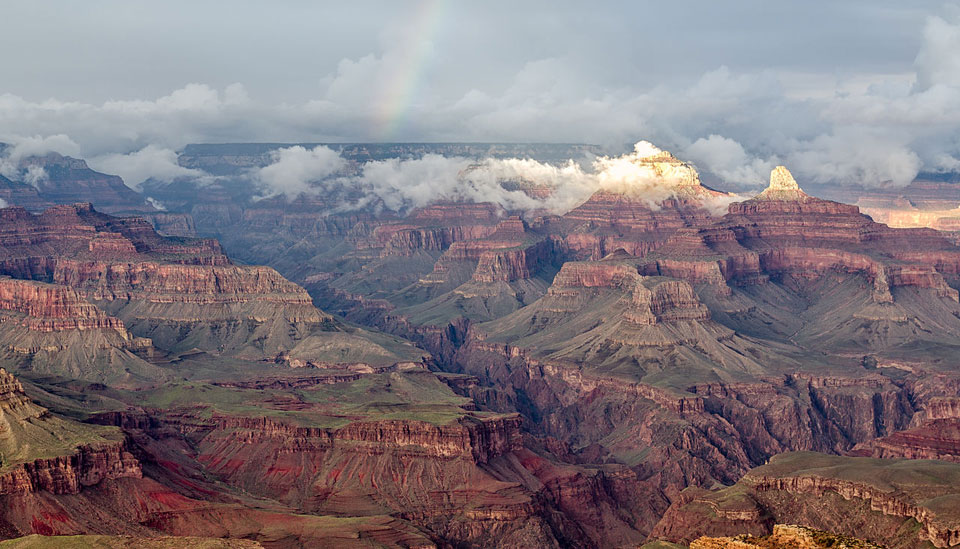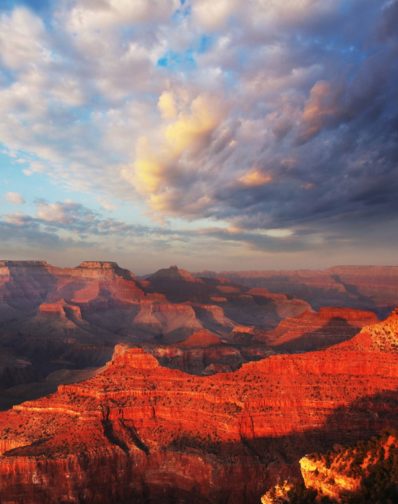
On Feb. 26, northwestern Arizona’s Grand Canyon National Park is officially 100 years old. Established in 1919, it is managed by the National Park Service. It was the 15th set-aside named as a U.S. national park, Yellowstone being the first in 1872. In 2017 Grand Canyon welcomed more than six million recreational visitors, second only, among all American national parks, to Great Smoky Mountains National Park, which is accessible to the much larger population centers of the East Coast.
Comprising 1902 square miles, the immense site along a gorge of the Colorado River, features layered bands of multicolored rock revealing millions of years of geological history. Standpoints along its popular South Rim and its less frequented North Rim provide visitors with innumerable opportunities for picture-postcard views of the mile-deep cavity in the land. The river runs for 277 miles through the canyon’s eroded crevice, which in places spans up to 18 miles wide.
For millions of Americans, and for tourists from around the world, a visit to the Grand Canyon is an unforgettable experience inspiring overwhelming wonderment and veneration at nature’s majesty. Viewers contemplate the mysteries of time, the ineluctable forces of water and wind erosion, the smallness of humanity in this presence and at the same time the large impact human activity can exert in the natural environment—and almost inevitably the impossibility of a “creation” a mere five or six thousand years ago. Almost anywhere you point your camera, in any weather at any season, you will come away with some remarkable photographs of a phenomenon often considered one of the Wonders of the World.
The Grand Canyon, located in unincorporated areas of Arizona’s Coconino and Mohave counties, was designated a World Heritage Site by UNESCO in 1979.
Most of present-day Arizona had formed part of Alta California of New Spain, which was ceded to the United States in 1848 after the Mexican-American War. Far from any European city or settlement, the Grand Canyon remained unknown to white explorers. Lt. Joseph Christmas Ives led an expedition to the area in 1858, and wrote, “Ours has been the first and, doubtless, will be the last party of whites to visit this profitless locality.” Clearly he had been searching for things of monetary value. “It seems intended by nature,” he continued, “that the Colorado River along the greater portion of its lonely and majestic way shall be forever unvisited and undisturbed.”
In the millennia before the arrival of Europeans, the Grand Canyon was well known to the Native Yavapai, Apache and Hopi nations. Guided by Hopi residents of the area, Spanish explorers apparently reached the canyon in the 1540s and descended partway down, but left with little appreciation for its vastness and depth. They must also have been searching for valuable minerals, for their accounts of the bleak and “profitless” terrain no doubt discouraged other visitors to the region for at least three centuries.
Native cultures still continued to hold the Grand Canyon in reverence as a place of spiritual emergence. They also foraged the area for plants and nuts, and hunted wild animals for food. The Havasupai people still maintain their reservation in the depths of the canyon.
Relative to altitude, wind, and proximity to the river, the Grand Canyon teems with over 500 species of animals in its several ecosystems. The endangered California condor is one of hundreds of bird species found there. Mammals inhabiting the park include coyotes, bats, mule deer, bighorn sheep, mountain lions and elk, as well as many types of arachnids, insects, scorpions and snakes.
As the West became permanently occupied by European settlers, word of the Grand Canyon began to spread. Early explorers came on boat, foot and horseback, often with Native guides, to navigate river rapids, hike the trails, and camp under the stars. By the 1880s, wealthy people could hire a stagecoach from Flagstaff for the two-day trip to a point on the canyon’s South Rim.

A passenger train first brought visitors in from Williams in 1901, but the railroad was more invested in hauling copper than carrying tourists. By the 1930s, most visitors arrived by automobile.
The road to becoming a national park was lengthy. Beginning in the 1880s there were several congressional bills that went nowhere. Enterprising businessmen sought to monetize the locale by charging money for hikes down the Bright Angel Trail and for outhouse use, developing camping sites, selling drinking water and souvenirs. Gradually they erected hotels along the South Rim. They feared that if the area was named a national park they might lose the money they made from tourism under private entrepreneurship.
In 1903, when Arizona was still a territory, not a state, Pres. Theodore Roosevelt first visited, saying:
“The Grand Canyon fills me with awe. It is beyond comparison—beyond description; absolutely unparalleled throughout the wide world…. Let this great wonder of nature remain as it now is. Do nothing to mar its grandeur, sublimity and loveliness. You cannot improve on it. But what you can do is to keep it for your children, your children’s children, and all who come after you, as the one great sight which every American should see.”
After making other visits to the area, Roosevelt declared the Grand Canyon a National Monument in 1908.
Pres. Woodrow Wilson signed legislation to create Grand Canyon National Park on Feb. 26, 1919, but Teddy Roosevelt is rightly credited for its early preservation. In the years after World War II, with a high-density unionization of the labor force which guaranteed good wages, benefits and vacations, and especially with the establishment of the interstate highway system, the Grand Canyon first hit 1 million visitors annually in 1956. The National Park Service also began to modernize its facilities and position itself as a public entity within the tourist sector.
During Pres. Trump’s partial federal government shutdown in December and January that closed some other U.S. national parks, the Grand Canyon remained open because Arizona decided to supply funds needed to keep trails, shuttles and restrooms open. The state clearly recognized that when government runs efficiently, both business and labor thrive.
Perhaps because the Grand Canyon was perceived as “profitless” except for tourism, it has been spared the axe in Trump’s campaign to privatize our commonly owned treasure. Other national parks, many of them of more recent vintage, such as those created by Pres. Obama, have not been so lucky, as the White House and its GOP friends in Congress attempt to turn this precious national heritage over to the fossil fuel and mining industries. Americans are still being challenged to guard this legacy jealously for, as Teddy Roosevelt said, “all who come after.”










